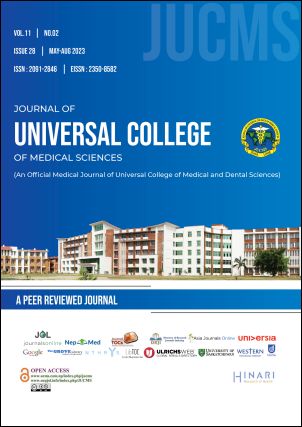Is It Not The Right Time To Consider Trivalent Mumps Vaccine (MMR) In The National Immunization Programme of Nepal? If Not Now, Then When?
DOI:
https://doi.org/10.3126/jucms.v11i02.57795Keywords:
Imunization programme, VaccinationAbstract
Vaccination is the process of administration of a vaccine to help the immune system develop immunity from a disease resulting in reduction of child mortality, morbidity and disability in vaccine preventable diseases. Nepal started its pilot vaccination program in 1979 (2034 B.S) and after a decade (1989), the Expanded Program on Immunization (EPI) was followed to the whole country with the aim of universal vaccination in children.
National immunization programme (NIP) provides vaccination services free of cost to the children living in marginalized communities and geographical regions difficult to reach through outreach sessions. Although many more vaccines have been added to the NIP of Nepal since then, vaccination against mumps is still missing. Nepalese children are being vaccinated with MR vaccine (measles and rubella) at 9 completed months and a booster at 15 months in spite of MMR (measles, mumps and rubella) vaccine. The time to re-think and consider mumps vaccine (MMR) in the immunization schedule of Nepal by the government of Nepal has arrived now. Including MMR vaccine in the national immunization schedule would ultimately result in the reduction of the outbreaks and associated morbidity that occur annually along with the economic benefits.
Downloads
Downloads
Published
How to Cite
Issue
Section
License
Copyright (c) 2023 Journal of Universal College of Medical Sciences

This work is licensed under a Creative Commons Attribution-NonCommercial 4.0 International License.
Authors have to give the following undertakings along with their article:
- I/we declare that this article is original and has not been submitted to another journal for publication.
- I/we declare that I/we surrender all the rights to the editor of the journal and if published will be the property of the journal and we will not publish it anywhere else, in full or part, without the permission of the Chief Editor.
- Institutional ethical and research committee clearance certificate from the institution where work/research was done, is required to be submitted.
- Articles in the Journal are Open Access articles published under the Creative Commons CC BY-NC License (https://creativecommons.org/licenses/by-nc/4.0/)
- This license permits use, distribution and reproduction in any medium, provided the original work is properly cited, and it is not used for commercial purposes.




